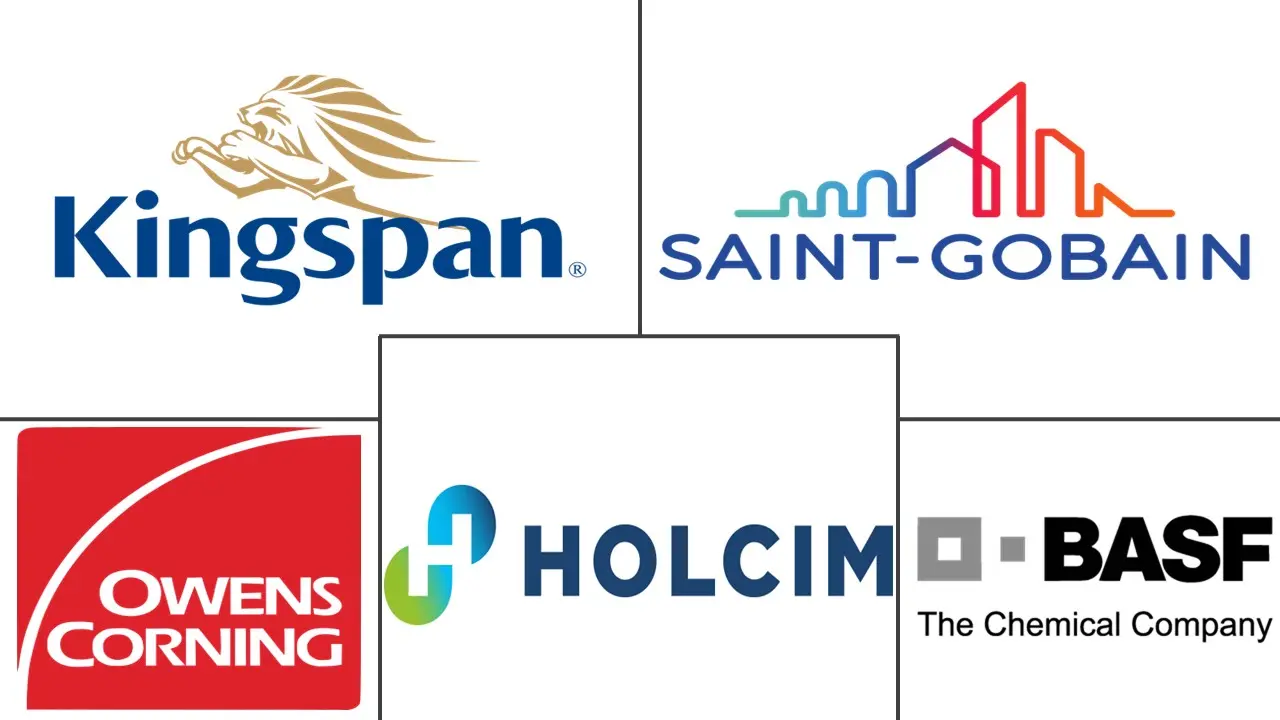Green Building Materials Market Size and Share
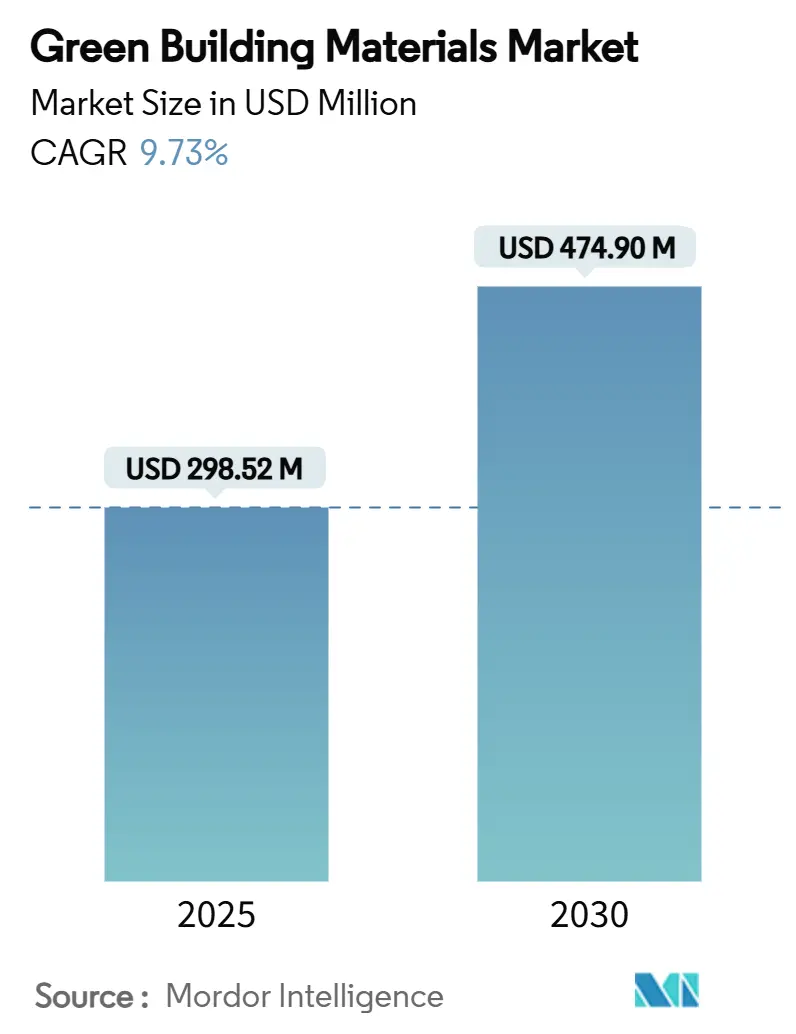
Green Building Materials Market Analysis by Mordor Intelligence
The Green Building Materials Market size is estimated at USD 298.52 million in 2025, and is expected to reach USD 474.90 million by 2030, at a CAGR of 9.73% during the forecast period (2025-2030). The outlook reflects sustained policy pressure for zero-emission construction, rising corporate net-zero commitments and rapid scaling of low-carbon material technologies. Regulatory alignment between the European Union, the United States and other major economies is eliminating historical fragmentation, enabling global manufacturers to capture scale efficiencies and accelerate product innovation. Demand is further supported by financial incentives that narrow the price gap with conventional products, while digital material-tracking tools are beginning to monetise end-of-life value streams. Together, these forces are triggering the fastest adoption cycle the green building materials market has experienced to date.
Key Report Takeaways
- By material type, low-carbon concrete and cement led with 24.45% of green building materials market share in 2024, while cellulose and bio-foam insulation is projected to climb at a 10.59% CAGR through 2030.
- By application, framing accounted for 23.29% of the green building materials market size in 2024; insulation is forecast to expand at a 10.18% CAGR to 2030.
- By end-use industry, residential construction held 39.81% of green building materials market share in 2024, whereas commercial projects are poised to grow at a 9.90% CAGR over the same period.
- By geography, North America commanded 40.80% of the green building materials market size in 2024; Asia-Pacific is set to rise at an 11.36% CAGR through 2030.
Global Green Building Materials Market Trends and Insights
Drivers Impact Analysis
| Driver | (~) % Impact on CAGR Forecast | Geographic Relevance | Impact Timeline |
|---|---|---|---|
| Mandatory Energy-Efficiency Codes Tightening | +2.5% | Global, with EU and North America leading | Medium term (2-4 years) |
| Government Incentives and Certification Schemes | +2.1% | North America and EU, expanding to APAC | Short term (≤ 2 years) |
| Corporate Net-Zero, Embodied-Carbon Procurement | + 1.8% | Global, concentrated in developed markets | Medium term (2-4 years) |
| Retrofit Wave for Ageing Building Stock | +1.2% | North America and EU core markets | Long term (≥ 4 years) |
| Digital Material Passports Monetising End-Of-Life Value | +0.9% | EU pioneering, global adoption following | Long term (≥ 4 years) |
| Source: Mordor Intelligence | |||
Mandatory Energy-Efficiency Codes Tightening
Worldwide building codes are shifting from voluntary guidelines to binding performance standards. In Europe, the revised Energy Performance of Buildings Directive requires all new buildings to achieve zero on-site fossil-fuel emissions by 2030, and existing residential stock must upgrade to at least an E rating by the same year. The United States is following with the 2024 International Energy Conservation Code, which streamlines state adoption and adds life-cycle carbon provisions. Stricter codes boost demand for high-performance insulation, low-carbon concrete and advanced façades, rewarding suppliers that can verify product sustainability through digital compliance platforms. Enhanced enforcement further raises compliance costs for traditional materials, creating durable competitive advantages for certified alternatives.
Government Incentives and Certification Schemes
Tax credits, green bonds and preferential financing are transforming project economics. The US Inflation Reduction Act’s Section 45L offers up to USD 5,000 per qualifying housing unit, and the 179D deduction now covers larger commercial upgrades[1]U.S. Department of Energy, “Inflation Reduction Act Tax Credits,” energy.gov. Canada has earmarked CAD 10 billion for clean-energy infrastructure, funnelling capital toward certified materials. With programs such as LEED, WELL and ENERGY STAR now linked to discounted financing, developers can offset the 15–25% price premium associated with advanced products. These incentives accelerate adoption in cost-sensitive segments and create reliable revenue streams for manufacturers that maintain up-to-date certification portfolios.
Corporate Net-Zero, Embodied-Carbon Procurement
The Science Based Targets initiative obliges companies to reduce emissions 50% by 2030 and 90% by 2050. Procurement teams therefore screen suppliers on verified product carbon footprints in addition to cost and performance. The US Federal Buy Clean Initiative extends these expectations to federal contracts, mandating transparent greenhouse-gas reporting. Major buyers such as Salesforce require suppliers to provide carbon-neutral products, pushing the green building materials market toward comprehensive life-cycle disclosure.
Retrofit Wave for Ageing Building Stock
Buildings constructed before modern energy codes dominate the current stock, offering 40% energy-saving potential through deep retrofits. The United Kingdom estimates that 80% of today’s structures will still be in use by 2050, compelling an upgrade cycle that favours modular exterior panels and drop-in insulation systems. US states including New York and California have launched rebate programs and technical assistance packages, while financial markets are rewarding retrofitted assets with higher valuations and lower insurance premiums. Manufacturers that provide turnkey retrofit solutions and skilled-labour support stand to benefit as funding shifts from new build to refurbishment.
Restraints Impact Analysis
| Restraint | (~) % Impact on CAGR Forecast | Geographic Relevance | Impact Timeline |
|---|---|---|---|
| High upfront cost of certified materials | -1.4% | Global, pronounced in price-sensitive markets | Short term (≤ 2 years) |
| Certification and performance complexity across regions | -0.8% | Global, fragmentation highest in emerging markets | Medium term (2-4 years) |
| Bio-based feedstock supply crunch post-2027 | -0.6% | Regions with limited biomass infrastructure | Long term (≥ 4 years) |
| Source: Mordor Intelligence | |||
High Upfront Cost of Certified Materials
Certified products typically command 15–25% price premiums owing to testing, specialised processing and smaller production runs. The premium is most acute in residential construction, where buyers focus on first-cost and may overlook lifecycle savings. Novel products such as carbon-negative concrete or bio-based insulation also carry R&D amortisation charges. While declining as volumes rise and carbon pricing narrows cost differentials, elevated upfront expense remains a near-term adoption barrier, particularly in developing regions without robust incentive programs.
Certification and Performance Complexity Across Regions
Manufacturers face multiple, overlapping certification protocols—LEED and ENERGY STAR in North America, BREEAM in Europe, China’s 3-Star system and national schemes elsewhere. Divergent metrics and documentation raise compliance costs and lengthen product-development cycles. Smaller suppliers struggle to resource multi-regional certification, slowing their entry into the green building materials market. Harmonisation efforts are under way, but medium-term friction persists, especially in fast-growing emerging economies.
Segment Analysis
By Material Type: Low-Carbon Concrete Leads Innovation Wave
Low-carbon concrete and cement captured 24.45% of green building materials market share in 2024, underscoring industry urgency to abate the 8% of global greenhouse-gas emissions linked to conventional cement. Breakthrough technologies such as mineral-carbonation processes that sequester 45% CO₂ while preserving strength have transitioned from pilot to limited commercial scale. Heidelberg Materials’ Lengfurt project will capture 70,000 t of CO₂ per year, signalling mainstream viability. Recycled metals retain reliable demand as structural steel routinely contains 93% scrap content and achieves 98% recovery rates at end-of-life. Engineered wood products, notably cross-laminated timber, are expanding as developers capitalise on faster assembly, lighter foundations and on-site carbon storage. Mineral-wool insulation remains a staple thanks to new non-combustible product lines, while cellulose and bio-foam insulation is progressing at a 10.59% CAGR, supported by renewable feedstocks and high thermal performance. Recycled-plastic composites are growing more selectively as lifecycle assessments raise concerns over micro-plastic shedding, although wood-polymer boards continue to penetrate exterior decking and façade niches.
Growth prospects vary across materials. Low-carbon binders benefit from inflight carbon-capture subsidies and will accelerate once carbon pricing regimes scale. Mass-timber markets hinge on expanded certified forestry capacity and revisions to height limits in building codes. Cellulose’s trajectory depends on securing sufficient post-consumer paper streams and scaling enzymatic treatment plants. Overall, material innovation reinforces competitive differentiation, compelling incumbents to integrate circular-economy features, verified carbon footprints and digital passports into every product line.
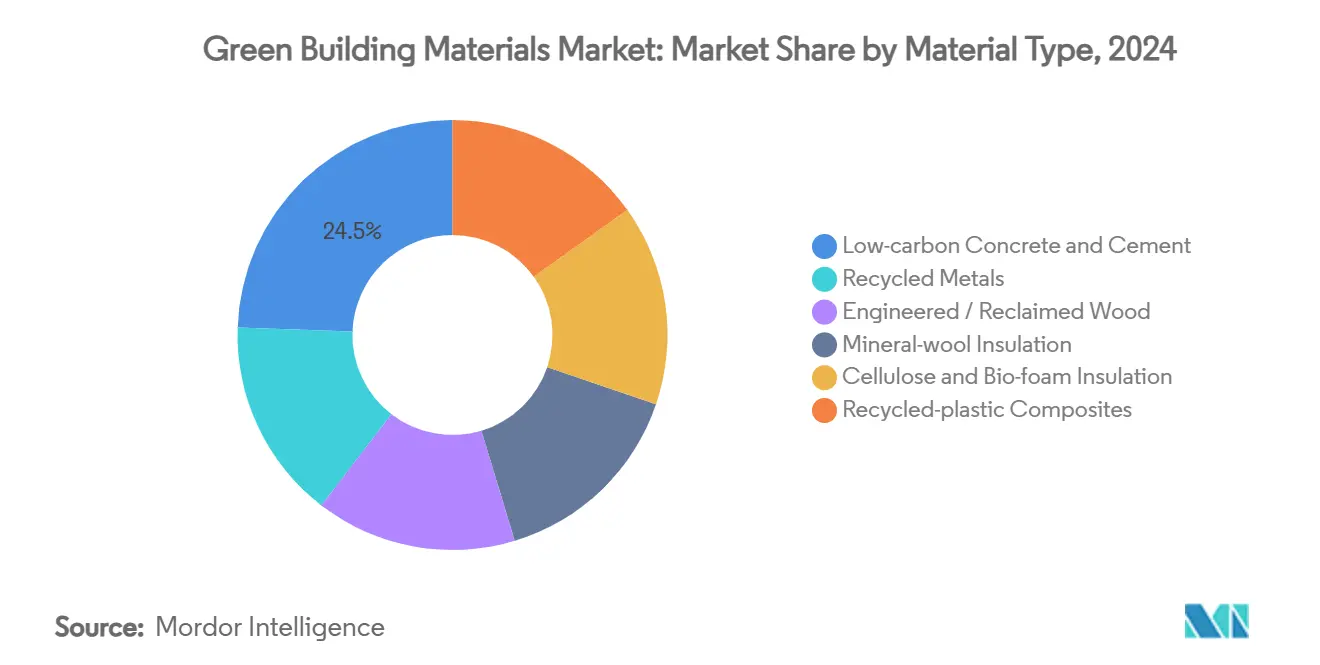
Note: Segment shares of all individual segments available upon report purchase
By Application: Insulation Drives Performance Revolution
Framing dominated with 23.29% of green building materials market size in 2024 as load-bearing components constitute the first specification decision in any project. Yet insulation is on course for a 10.18% CAGR through 2030, propelled by code-mandated R-value increases and the retrofit drive. Insulation upgrades deliver the most cost-effective energy savings, elevating demand for high-performance mineral-wool batts, cellulose spray-ins and bio-foam panels. Roofing applications benefit from integrated systems such as photovoltaic-ready insulated panels that satisfy both thermal and renewable-energy criteria. Exterior siding is moving toward composite systems combining weatherisation membranes, structural sheathing and insulation in a single assembly. Interior finishing materials must now demonstrate low volatile-organic-compound emissions and circular end-of-life pathways to satisfy stringent wellness certification and demolition-waste diversion targets. Specialised systems for data centres, hospitals and industrial facilities are gaining traction, as these sectors carry heightened uptime and sustainability requirements that favour prefabricated, rapidly instal¬led assemblies.
Developers pursue envelope performance because it yields immediate operational-carbon savings and complements on-site renewable generation. As building-energy models shift to whole-life-carbon metrics, the envelope’s embodied-carbon content also becomes critical, giving an edge to products combining high R-values with recycled or biogenic feedstocks. Manufacturers able to bundle insulation, air-barrier and moisture-control layers into digitally traced modules occupy the most defensible strategic positions.
By End-User Industry: Commercial Sector Accelerates Adoption
Residential projects retained 39.81% green building materials market share in 2024, bolstered by tax incentives that offset consumer price sensitivity. Builders now routinely specify ENERGY STAR windows, low-carbon concrete slabs and formaldehyde-free interior panels. Commercial construction, however, is projected to pace the market with a 9.90% CAGR, powered by corporate ESG mandates that demand verifiable embodied-carbon reductions. Office landlords and logistics developers deploy green materials to attract tenants and investors seeking sustainable assets. Institutional clients, notably universities and hospitals, showcase pilot installations of modular mass-timber structures and cradle-to-cradle certified interiors, setting performance benchmarks later adopted by private projects. The infrastructure sector is beginning to integrate recycled asphalt, slag cement and low-carbon rebar as national governments link procurement criteria to climate targets.
Procurement patterns diverge by user. Residential buyers emphasise cost and installation speed, favouring pre-cut, lightweight components. Commercial owners prioritise third-party certification and total-cost-of-ownership modelling, accepting higher upfront pricing for performance warranties. Industrial operators require temperature and humidity control at scale, accelerating adoption of advanced insulation and reflective roofing. Across segments, life-cycle assessment is evolving from a marketing differentiator to a bid requirement, compelling suppliers to maintain transparent environmental-product declarations.
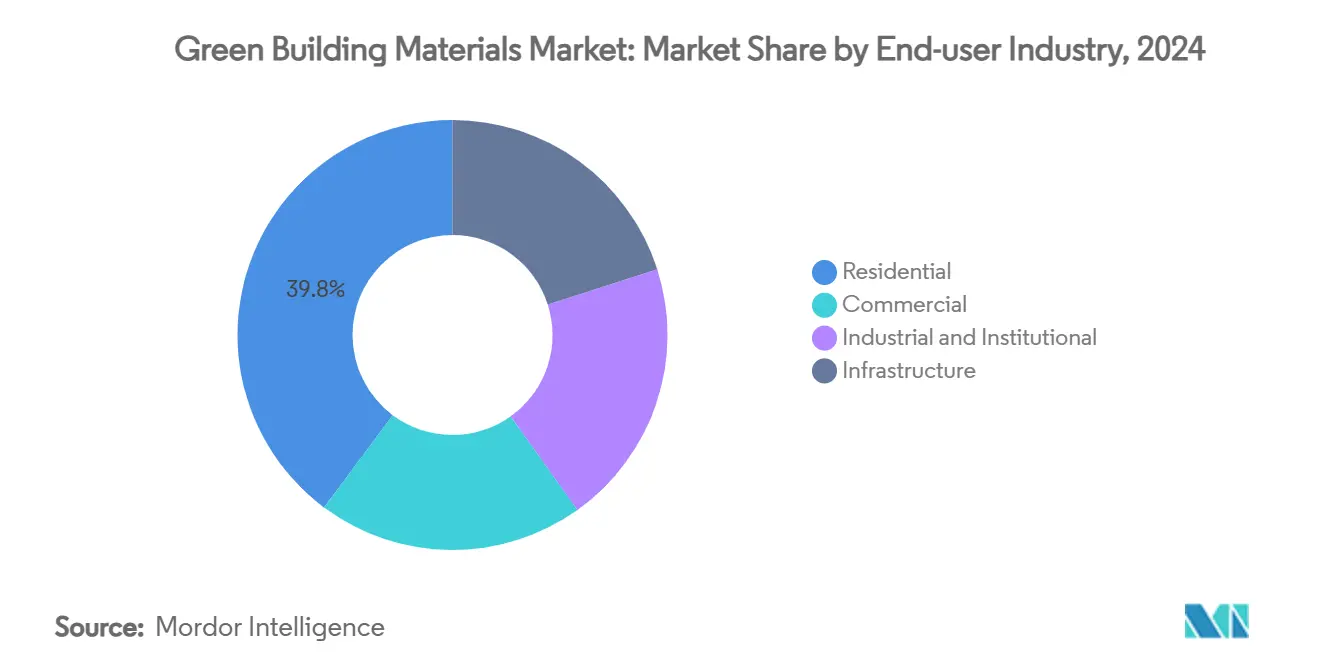
Note: Segment shares of all individual segments available upon report purchase
Geography Analysis
North America accounted for 40.80% of the green building materials market size in 2024, reflecting long-standing ENERGY STAR and LEED programmes and state-level zero-energy-ready building mandates. Federal tax credits under the Inflation Reduction Act strengthen national alignment, while California’s 2025 code cycle is expected to tighten embodied-carbon limits further. Canada’s Greener Homes Initiative funnels low-interest loans into retrofit upgrades, stimulating demand for cellulose and mineral-wool insulation.
Europe maintains a high adoption baseline due to the Energy Performance of Buildings Directive and the forthcoming Carbon Border Adjustment Mechanism, which together raise the cost of high-carbon imports and incentivise domestic low-carbon production. Scandinavian countries have already mandated whole-life-carbon assessments for all large buildings, accelerating demand for digital passports and mass timber. Germany and France lead public-sector procurement of low-carbon concrete, while the United Kingdom pilots circular-construction hubs to harvest reusable materials from urban demolition.
Asia-Pacific is forecast to expand at an 11.36% CAGR through 2030 as rapid urbanisation meets evolving green-building codes. China requires all new projects to achieve at least Basic Grade green certification by 2025, while several provinces have introduced embodied-carbon benchmarks. India’s Energy Conservation Building Code and Indonesia’s Green Building Council rating system are driving early adoption, though fragmented municipal enforcement tempers near-term volumes. Australia and Singapore, already mature, are exporting expertise across the region, reinforcing supply-chain localisation and regional certification standards.
South America and the Middle East and Africa remain nascent but attractive as infrastructure investment expands. Brazil’s Procel Edifica labelling system and the United Arab Emirates’ Estidama Pearl Rating System are encouraging material suppliers to localise production to meet climate-specific performance needs. Financing remains the principal hurdle; however, multilateral banks increasingly channel green bonds into these markets, setting the stage for accelerated uptake during the next planning cycle.
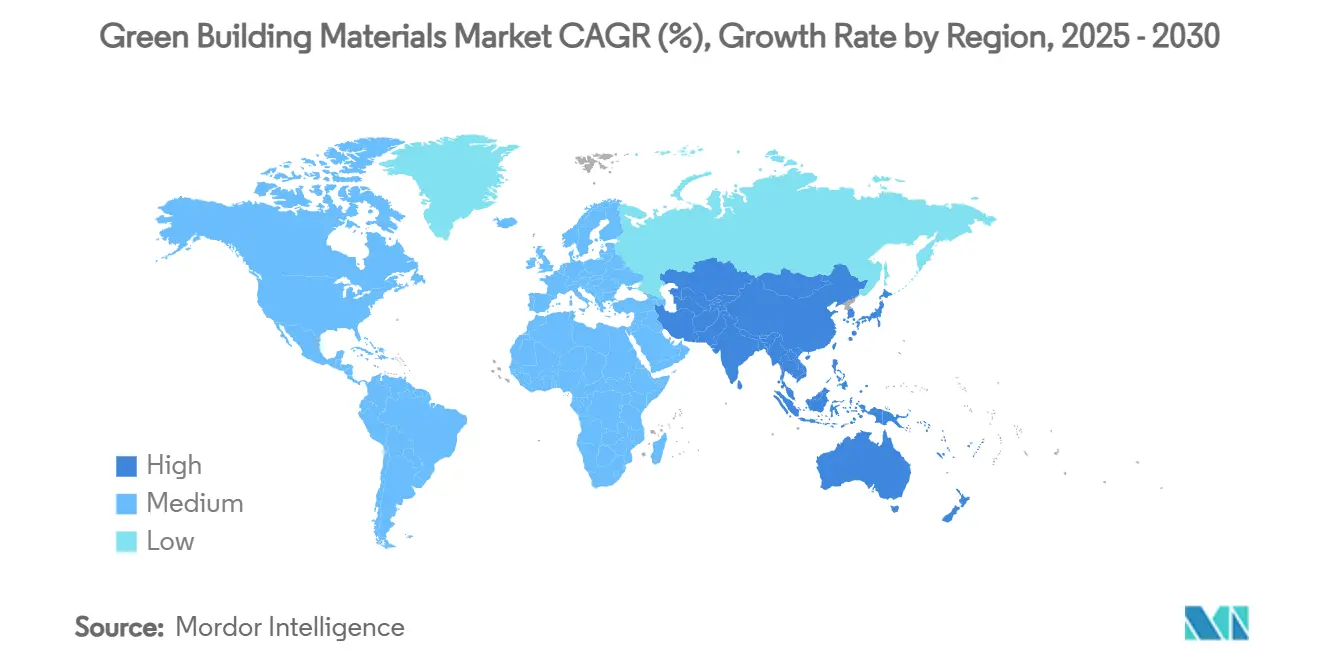
Competitive Landscape
The green building materials market is highly fragmented, with technological capability and certification breadth emerging as the principal competitive vectors. Global majors such as BASF, Holcim and Kingspan allocate multi-billion-dollar capital programmes to carbon-capture cement kilns, advanced insulation campuses and digital passport platforms. Holcim’s CHF 2 billion investment in carbon-capture-ready plants and BASF’s EUR 19.5 billion commitment to sustainable technologies illustrate the scale required to lead. Kingspan’s acquisition of timber-insulation specialist Steico demonstrates strategic diversification into bio-based segments[2]Kingspan Group plc, “Annual Report 2024,” kingspan.com.
Technology partnerships are proliferating. Cemex and Microsoft have co-developed a generative-AI platform that optimises mix design for performance and embodied-carbon targets, reducing development cycles for new low-carbon products. Heidelberg Materials collaborates with Linde on oxy-fuel combustion for cement, while Sika’s acquisition of Elmich brings green-roof and water-management systems into its portfolio. Disruptors such as Sublime Systems scale electro-chemical cement production that eliminates process CO₂, signalling potential leap-frog threats to incumbents.
Mergers and acquisitions target vertical integration and regional certification expertise. Holcim’s purchase of OX Engineered Products strengthens its North-American building envelope line, while Kingspan’s EUR 280 million Ukrainian campus enhances supply resilience in Eastern Europe. Investment flows increasingly favour circular-economy plays, with Cemex’s Regenera unit acquiring RC-Baustoffe Berlin to recycle 400,000 t of construction waste annually. Collectively, these moves indicate a shift toward closed-loop material ecosystems where digital tracking, carbon capture and bio-based feedstocks converge.
Green Building Materials Industry Leaders
-
Kingspan Group
-
Holcim Ltd
-
Owens Corning
-
Saint-Gobain
-
BASF SE
- *Disclaimer: Major Players sorted in no particular order
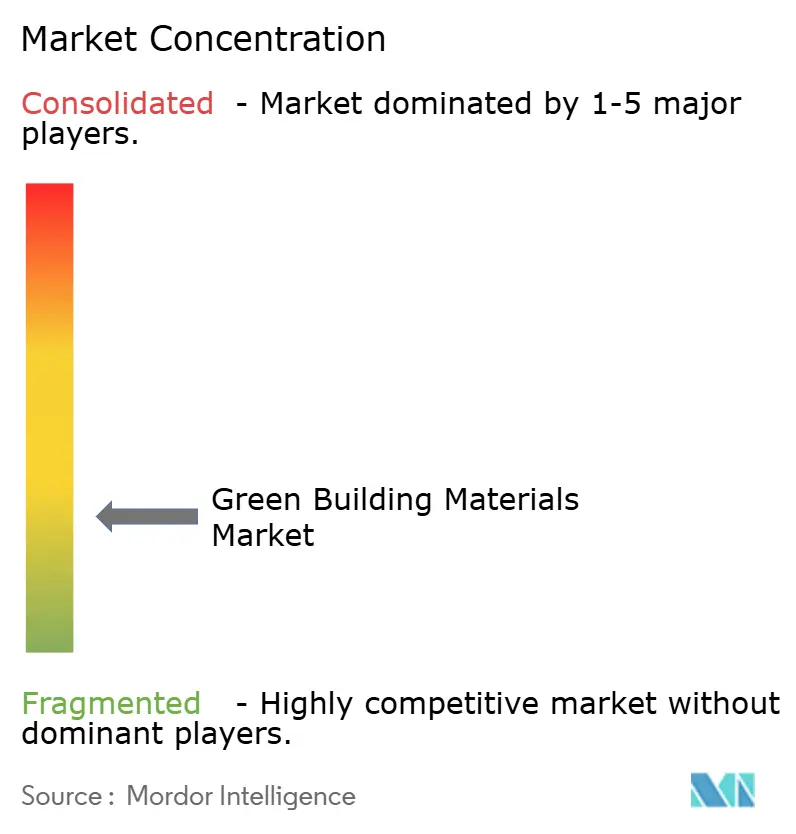
Recent Industry Developments
- May 2025: Coromandel International Ltd. formed a joint venture through its wholly-owned subsidiary Coromandel Chemicals Limited with Sakarni Plaster to manufacture and market phosphogypsum-based green building materials.
- April 2025: Kingspan Group announced plans to establish a EUR 280 million manufacturing campus in Ukraine for building technology. The facility will create more than 700 jobs and manufacture insulation and green building materials to support reconstruction initiatives.
Global Green Building Materials Market Report Scope
Green building materials are defined as materials that are non-toxic, environment-friendly, and sustainable, leading to improved occupancy health, lowered energy cost, and reduced energy consumption. The operating costs of green buildings are lower than that of regular buildings, with 63% lower water usage and 53% lower electricity usage.
The green building materials market is segmented by application, end-user industry, and geography. By application, the market is segmented into framing, insulation roofing, exterior siding, interior finishing, and other applications. By end-user industry, the market is segmented into residential, commercial, industrial and institutional, and infrastructure. The report also covers the market size and forecasts for the green building materials market in 15 countries across major regions. For each segment, the market sizing and forecasts have been done based on revenue (USD million).
| Low-carbon Concrete and Cement |
| Recycled Metals |
| Engineered / Reclaimed Wood |
| Mineral-wool Insulation |
| Cellulose and Bio-foam Insulation |
| Recycled-plastic Composites |
| Framing |
| Insulation |
| Roofing |
| Exterior Siding |
| Interior Finishing |
| Other Applications |
| Residential |
| Commercial |
| Industrial and Institutional |
| Infrastructure |
| North America | United States |
| Canada | |
| Mexico | |
| Europe | Germany |
| United Kingdom | |
| France | |
| Italy | |
| Rest of Europe | |
| Asia-Pacific | China |
| India | |
| Japan | |
| South Korea | |
| Rest of Asia-Pacific | |
| South America | Brazil |
| Argentina | |
| Rest of South America | |
| Middle-East and Africa | Saudi Arabia |
| South Africa | |
| Rest of Middle-East and Africa |
| By Material Type | Low-carbon Concrete and Cement | |
| Recycled Metals | ||
| Engineered / Reclaimed Wood | ||
| Mineral-wool Insulation | ||
| Cellulose and Bio-foam Insulation | ||
| Recycled-plastic Composites | ||
| By Application | Framing | |
| Insulation | ||
| Roofing | ||
| Exterior Siding | ||
| Interior Finishing | ||
| Other Applications | ||
| By End-user Industry | Residential | |
| Commercial | ||
| Industrial and Institutional | ||
| Infrastructure | ||
| By Geography | North America | United States |
| Canada | ||
| Mexico | ||
| Europe | Germany | |
| United Kingdom | ||
| France | ||
| Italy | ||
| Rest of Europe | ||
| Asia-Pacific | China | |
| India | ||
| Japan | ||
| South Korea | ||
| Rest of Asia-Pacific | ||
| South America | Brazil | |
| Argentina | ||
| Rest of South America | ||
| Middle-East and Africa | Saudi Arabia | |
| South Africa | ||
| Rest of Middle-East and Africa | ||
Key Questions Answered in the Report
What is the current value of the green building materials market and how fast is it growing?
The green building materials market size is USD 298.52 million in 2025 and is expected to reach USD 474.9 million by 2030, reflecting a 9.73% CAGR.
Which material category holds the largest market share?
Low-carbon concrete and cement hold the largest share at 24.45% in 2024, driven by rapid decarbonisation efforts in cement production.
Why is insulation the fastest-growing application?
Insulation delivers the highest return on energy-efficiency investments and is central to meeting tightening building-code R-value mandates, pushing the segment toward a 10.18% CAGR.
Which region will see the strongest expansion through 2030?
Asia-Pacific is projected to grow at an 11.36% CAGR owing to rapid urbanisation and new national green building requirements.
How are governments encouraging adoption of green building materials?
Incentives such as the US Section 45L tax credit, commercial 179D deductions and various grant programmes lower upfront costs and make certified products more competitive.
Page last updated on:
